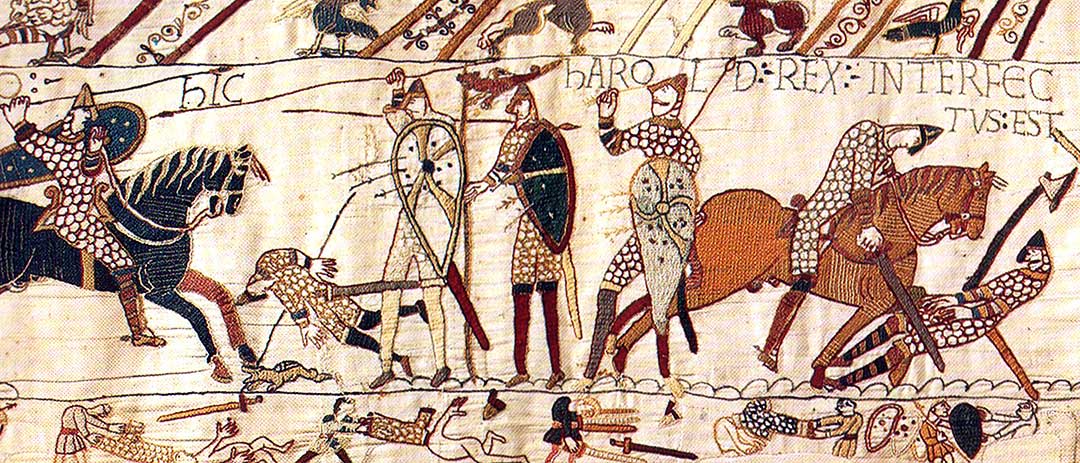The Norman Invasion 1066 and all that
| < Emergence of a Scottish Nation | Δ Index | The Normans and Scotland > |

The Bayeux Tapestry famously records the death of King Harold at the Battle of Hastings in 1066.
Once again, England faced a new invader – the Normans, and they were here to stay.
Over the next two centuries there were many battles, raids and wars across the Anglo-Scottish borders.
Norman Kings
| Reign | Name | Notes |
| 1066- 1087 | WILLIAM I (The Conqueror) | Also known as William the Bastard (but not normally to his face!), he was the illegitimate son of Robert the Devil, whom he succeeded as Duke of Normandy in 1035. William came to England from Normandy, claiming that his second cousin Edward the Confessor had promised him the throne, and defeated Harold II at the Battle of Hastings on 14th October 1066. In 1085 the Domesday Survey was begun and all of England was recorded, so William knew exactly what his new kingdom contained and how much tax he could raise in order to fund his armies. William died at Rouen after a fall from his horse whilst besieging the French city of Nantes. He is buried at Caen. |
| 1087-1100 | WILLIAM II (Rufus) | William was not a popular king, given to extravagance and cruelty. He never married and was killed in the New Forest by a stray arrow whilst out hunting, maybe accidentally, or possibly shot deliberately on the instructions of his younger brother Henry. Walter Tyrrell, one of the hunting party, was blamed for the deed. The Rufus Stone in The New Forest, Hampshire, marks the spot where he fell. |
| 1100-1135 | HENRY I | Henry Beauclerc was the fourth and youngest son of William I. Well educated, he founded a zoo at Woodstock in Oxfordshire to study animals. He was called the ‘Lion of Justice’ as he gave England good laws, even if the punishments were ferocious. His two sons were drowned in the White Ship so his daughter Matilda was made his successor. She was married to Geoffrey Plantagenet. When Henry died of food poisoning, the Council considered a woman unfit to rule and so offered the throne to Stephen, a grandson of William I. |
| 1135-1154 | STEPHEN | Stephen was a very weak king and the whole country was almost destroyed by the constant raids by the Scots and the Welsh. During Stephen’s reign the Norman barons wielded great power, extorting money and looting town and country. A decade of civil war known as The Anarchy ensued when Matilda invaded from Anjou in 1139. A compromise was eventually decided, under the terms of the Treaty of Westminster Matilda’s son Henry Plantagenet would succeed to the throne when Stephen died. |
Plantagenet Kings
| Reign | Name | Notes |
| 1154-1189 | HENRY II | Henry of Anjou was a strong king. A brilliant soldier, he extended his French lands until he ruled most of France. He laid the foundation of the English Jury System and raised new taxes (scutage) from the landholders to pay for a militia force. Henry is mostly remembered for his quarrel with Thomas Becket, and Becket’s subsequent murder in Canterbury Cathedral on 29th December 1170. His sons turned against him, even his favourite John. |
| 1189 – 1199 | RICHARD I (The Lionheart) | Richard was the third son of Henry II. By the age of 16, he was leading his own army putting down rebellions in France. Although crowned King of England, Richard spent all but 6 months of his reign abroad, preferring to use the taxes from his kingdom to fund his various armies and military ventures. He was the leading Christian commander during the Third Crusade. On his way back from Palestine, Richard was captured and held for ransom. The amount paid for his safe return almost bankrupt the country. Richard died from an arrow-wound, far from the kingdom that he so rarely visited. He had no children. |
| 1199 -1216 | JOHN | John Lackland was the fourth child of Henry II. Short and fat, he was jealous of his dashing brother Richard I whom he succeeded. He was cruel, self-indulgent, selfish and avaricious, and the raising of punitive taxes united all the elements of society, clerical and lay, against him. The Pope excommunicated him. On 15th June 1215 at Runnymede the barons compelled John to sign Magna Carta, the Great Charter, which reinstated the rights of all his subjects. John died – from dysentery – a fugitive from all his enemies. He has been termed “the worst English king”. |
| 1216 -1272 | HENRY III | Henry was 9 years old when he became king. Brought up by priests he became devoted to church, art and learning. He was a weak man, dominated by churchmen and easily influenced by his wife’s French relations. In 1264 Henry was captured during the rebellion of barons led by Simon de Montfort and was forced to set up a ‘Parliament’ at Westminster, the start of the House of Commons. Henry was the greatest of all patrons of medieval architecture and ordered the rebuilding of Westminster Abbey in the Gothic style. |
| < Emergence of a Scottish Nation | Δ Index | The Normans and Scotland > |